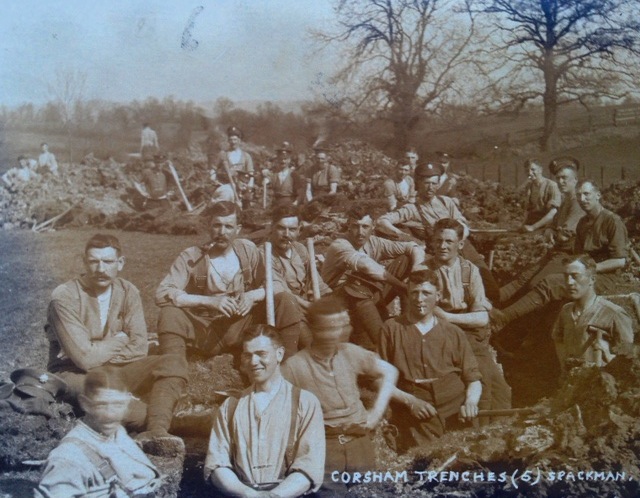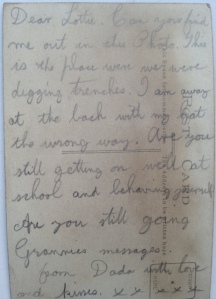Tagged: Flanders fields
Postcard from the Trenches
Oh boy, this is going to be hard to convey how emotional I feel right now…
One of my previous posts concerned the five IRVING brothers – none of whom survived the Great War.
Well, I was just going through the box of family history research that my Dad gave me recently. He had traced the direct line of RETTIE ancestors back to 1678 (before the internet, with many hours trawling through microfiche I bet). The box is full of his hand-drawn charts, magazine articles, newspaper clippings, hand-written notes, etc. There was a separate folder labelled ‘IRVING’ which I hadn’t looked into before now.
And inside I found something more precious than any medal…
Dear Lottie. Can you find me out in this Photo. This is the place w[h]ere we were digging trenches. I am away at the back with my hat the wrong way. Are you still getting on well at school and behaving yourself. Are you still going [for] Grannies messages. From Dada with love and kisses. x x x x x
Lottie is Charlotte, my Nana (my paternal Grandmother) and this postcard is written by her Dad, Private Hugh IRVING of the Scots Guards, killed 19th June 1917, Flanders.
I also found a picture titled ‘Sgt E.H. Trinder’s Squad, Scots Guards, November 1915’. I presume my Great-Grandfather is somewhere – this time with his hat the right way round!
I shall treasure these items forever and endeavour to find out more about Corsham trenches, the photographer(?) Spackman and Sgt Trinder.
Brothers in Arms: Earned in Blood
My last few posts have concentrated on the RETTIE line of my family tree, specifically the brothers of my Dad’s paternal Grandfather George RETTIE. This post concerns my Dad’s maternal Grandfather Hugh IRVING.
I knew Hugh was my Great-Grandfather a number of years ago, as I visited his grave in Belgium in 2001. So too did my son Bryan last year, on a school History trip to Flanders’ fields.
What I didn’t know until the other night was the devastating affect of the Great War on his family – on top of already great sadness at the early deaths of two other brothers…
My previous post re John RETTIE had made me aware of the War Graves Photographic Project, a partner site to the CWGC. I thought I would see how their picture of Hugh IRVING’s grave compared to my own and duly typed his name into the Search facility. What I didn’t expect was an entry coming up for Edinburgh Eastern Cemetery!
I could see it was a memorial inscription for the whole family, so duly ordered an email copy of the photograph (costs are suggested donation of £3.50 for email copy and £5.50 for hard copy).
The email arrived promptly the next day with the photo of the headstone:

IRVING family headstone, Edinburgh Eastern Cemetery. Courtesy of The War Graves Photographic Project.
Erected by Hugh & Charlotte Irving in loving memory of their sons.
JOHN died 13th January 1895, aged 18.
WILLIAM died 30th July 1909, aged 18.
HUGH killed 19th June 1917, aged 36.
CHARLES killed 13th July 1917, aged 29.
FREDERICK killed 20th October 1918, aged 37.
Also the above
HUGH IRVING died 18th August 1928, aged 77
and his beloved wife
CHARLOTTE LEEDER died 6th September 1928, aged 78.
Hugh IRVING was a Blacksmith and before the Great War, he and his wife Charlotte had lost their sons John and William (both Apprentice Boilermakers) to illness – Tuberculosis and Appendicitis respectively – at the tender age of 18.
If that wasn’t bad enough, imagine the grief when, within a month of each other, two more sons are killed in battle and, a year later, the fifth and final son is killed in France? Truly incomprehensible…
The three brothers killed in action had all joined separate units – Hugh the Scots Guards, Charles the Highland Light Infantry and Frederick the Royal Scots Fusiliers. If this was an attempt to spread out to avoid them all being unlucky enough to be in the same place at the wrong time, it proved a futile tactic.
They went with songs to the battle, they were young.
Straight of limb, true of eyes, steady and aglow.
They were staunch to the end against odds uncounted,
They fell with their faces to the foe.
They shall grow not old, as we that are left grow old:
Age shall not weary them, nor the years condemn.
At the going down of the sun and in the morning,
We will remember them.
‘For the Fallen’, Laurence Binyon, 1914.





